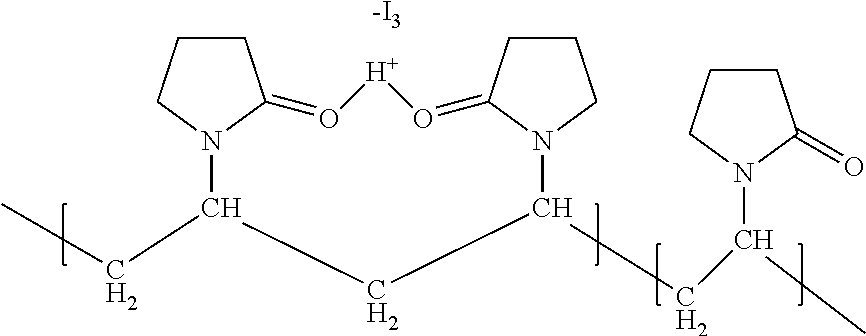Novel slow-releasing ophthalmic compositions comprising povidone iodine
a technology of ophthalmic compositions and iodine, which is applied in the field of ophthalmic disorders, can solve the problems of inability to economically realize the diagnosis of various causative agents such as bacteria, virus or fungus, and inability to accurately diagnose infectious conjunctivitis,
- Summary
- Abstract
- Description
- Claims
- Application Information
AI Technical Summary
Benefits of technology
Problems solved by technology
Method used
Image
Examples
example 1
Preparation of Slow-Releasing Povidone Iodine Ophthalmic Composition
[0060]A composition of this invention can be prepared as follows:
[0061]Step 1: Povidone iodine and sodium alginate were fully dissolved in water with adjustment of pH to 4.0˜5.0 to make Solution A. Microspheres encapsulating povidone iodine were formed when spraying Solution A into a calcium chloride solution. The microspheres were then filtered and dried. The calcium chloride solution concentration was preferred to be 1%˜5%.
[0062]Step 2: Povidone iodine, a metal ion chelating agent, a pH adjusting agent, microspheres stabilizer, and a suspending agent were poured into proper amount of water and mixed, adjusting pH to 4.0˜5.0, to make Solution B, which was filled into the eye drop bottle.
[0063]Step 3: Microspheres encapsulating povidone iodine and alginate was poured into Solution B to make a povidone iodine slow-releasing ophthalmic composition.
example 2
Microspheres Dissolution Study
[0064]
TABLE 1(Unit: gram)sodiumalginate / povidonesodiumpovidoneAddingFormulationiodine ratioalginateiodinewater to11:10.50.5100 g22:110.533:11.50.544:120.555:12.50.566:130.577:13.50.5
[0065]Preparation of 7 formulations of microspheres (listed above in table 1) was conducted according to the method described in Example 1. In Formulation 7, the concentration of sodium alginate was too high to dissolve, which resulted in no microspheres being formed.
[0066]Artificial tear configuration: 0.24 g anhydrous calcium chloride and 27.4 g sodium chloride were added into 4000 mL pure water, and the pH of the resultant solution was adjusted using NaOH to 6.8˜7.2, for back-up.
[0067]Dissolution method: 0.5 g microsphere was added into 100 mL artificial tears and time was recorded. Write down the situation and period of time about the change in color of the microsphere—from brown to white. Table 2 below shows the result of the microsphere dissolution study:
TABLE 2About 3...
example 3
Stability Studies
[0069]Table 3 shows formulations for testing samples and control samples.
TABLE 3(Unit: gram)Add PVP-IPVP-IHydroxyl-pureFor-micro-pow-glyc-EDTA-ethyl-water mulaspheresNaClCaCl2dererolNacelluloseto110.90.080.120.011.5100 g210.90.5 1 20.011.5310.9 / 0.120.011.5410.9 / 1 20.011.5510.90.08 / 20.011.5610.90.5 / 20.011.5710.9 / / 20.011.5
[0070]Povidone iodine microspheres were made according to method described in Example 1. Stabilities of formulations listed in Table 3 were studied at 40° C. accelerated conditions.
[0071]At day 0, 5 and 10, 2 bottles of PVP-I eye drops were taken out and filtered through microfiltration membrane to filter microspheres. A 3% CaCl2 solution was used to rinse the microspheres twice, which were then allowed to dry. The microspheres' corrosion was studied. Table 4 shows accelerated testing results:
TABLE 40 day5 days10 daysMicro-Micro-Micro-spherespheresphereCor-weight weight weight rosion (g)shape(g)shape(g)shape10.311 Brown and0.2965Brown and0.2814Bro...
PUM
| Property | Measurement | Unit |
|---|---|---|
| Fraction | aaaaa | aaaaa |
| Fraction | aaaaa | aaaaa |
| Fraction | aaaaa | aaaaa |
Abstract
Description
Claims
Application Information
 Login to View More
Login to View More - R&D
- Intellectual Property
- Life Sciences
- Materials
- Tech Scout
- Unparalleled Data Quality
- Higher Quality Content
- 60% Fewer Hallucinations
Browse by: Latest US Patents, China's latest patents, Technical Efficacy Thesaurus, Application Domain, Technology Topic, Popular Technical Reports.
© 2025 PatSnap. All rights reserved.Legal|Privacy policy|Modern Slavery Act Transparency Statement|Sitemap|About US| Contact US: help@patsnap.com


